The construction of data centers requires significant planning and engineering to ensure they can reliably and securely support mission critical infrastructure and operations. Data centers house thousands of servers, networking equipment and other IT systems that store, process and transmit massive amounts of data and enable core business functions. With organizations increasingly reliant on digital technologies, data center construction has become a strategic priority that demands a meticulous, multi-faceted process.
Site Selection
One of the earliest and most important steps in data center construction is selecting the ideal site location. Key factors evaluated include proximity to fiber optic lines, availability of redundant power sources, accessibility to major transportation routes and climate conditions. Sites near internet backbones provide the lowest latency connectivity essential for modern applications. Areas with stable utility infrastructure reduce risks of power outages disrupting operations. Mild weather also helps lower energy costs for cooling servers. Local tax incentives and community impacts are additional considerations.
Designing for High Availability
Data centers are purpose-built for 99.99% service availability which translates to less than an hour of downtime per year. Architectural designs implement redundancy across all critical systems to minimize single points of failure. Backup generators ensure continuous power supply during grid failures. N+1 redundancy is common for cooling systems, ensuring sufficient capacity even if one unit malfunctions. Floorplans incorporate flexible space, raised floors and high ceilings to accommodate new technologies. Fire suppression, security and emergency preparedness features guard against threats to uptime.
Building Infrastructure
Construction involves integrating robust physical infrastructure with advanced mechanical and electrical systems. Reinforced concrete is used for raised floors that house cabling while drywall or sheetrock partitions separate hot and cold aisles. Cooling plants feature redundant chillers, cooling towers and computer room air handlers (CRAH/CRAC) to remove excessive heat. Uninterruptible power supply (UPS) and diesel generators maintain power even during outages. Monitoring systems enable remote management of environments, security access and troubleshooting issues. Fiber optic cabling with diverse paths provides high-speed connectivity within and outside premises.
Deployment of IT Equipment
Once structural work and facilities are completed, Data Center Construction operators deploy and configure racks of servers and storage arrays. Careful project management coordinates equipment installation with network engineers and application teams. Factors like power consumption, cooling requirements and connectivity influence equipment layout across data hall floors. Dense configurations maximize floor space while maintaining adequate clearances. Cabling management and labeling standards streamline troubleshooting and capacity planning. Comprehensive testing validates infrastructure, applications, security controls and backup solutions before client migration.
Ongoing Operations
After deployment, data centers transition to facility management focusing on energy efficiency, scalability, compliance and optimizations. Monitoring tools track power usage effectiveness (PUE) to reduce carbon footprint. Modular designs allow incremental expansion without disrupting clients. Housekeeping maintains clean rooms and prevents dust accumulation. Regular maintenance checks generators, UPS systems and mechanical plants. Applied best practices lower costs through server virtualization, storage consolidation and right-sizing cooling. Periodic audits ensure adherence to regulations, certifications and service level agreements. With care and diligence, data centers can deliver mission-critical services reliably for decades.
Expansion Planning
As cloud adoption accelerates, constant upgrades are needed to support new workloads and ever-growing data volumes. Data centers proactively plan infrastructure expansions through meticulous capacity management. Power and space utilizations are tracked to identify hot spots. Scalable designs with sufficient land reserves allow phased construction of additional data halls, servers and networking equipment without disrupting current operations. Redundancies including backup generators, cooling towers and electrical lines pave the way for compound annual growth rate of 20-30% typical in the industry. Strategic long-term investments aim to keep data centers operating on the cutting edge for the next 10-15 years.
*Note:
1. Source: Coherent Market Insights, Public sources, Desk research
2. We have leveraged AI tools to mine information and compile it

